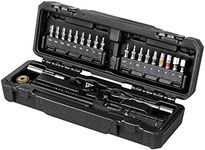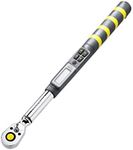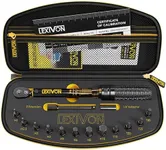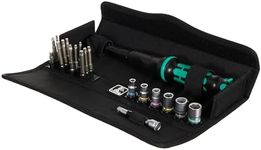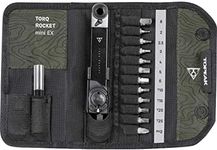Buying Guide for the Best Bike Torque Wrench
Choosing the right bike torque wrench is essential for maintaining your bike and ensuring that all bolts and components are tightened to the correct specifications. A torque wrench helps you apply the right amount of force, preventing damage to your bike and ensuring safety. Here are some key specifications to consider when selecting a bike torque wrench and how to choose the best one for your needs.Torque RangeThe torque range indicates the minimum and maximum torque values that the wrench can measure. This is important because different bike components require different torque settings. For example, delicate carbon parts need lower torque settings, while bottom brackets and cranksets need higher torque. Torque wrenches typically come in ranges like 2-20 Nm, 5-25 Nm, or 10-60 Nm. If you work on a variety of bike parts, a wrench with a broader range is more versatile. Choose a torque range that covers the specifications of the components you frequently work on.
AccuracyAccuracy refers to how close the torque wrench's readings are to the actual torque applied. This is crucial for ensuring that bolts are tightened correctly without over-tightening or under-tightening. Most quality torque wrenches have an accuracy of ±3-4%. Higher accuracy is better, especially for precision work on high-end bikes. Look for a torque wrench with a high accuracy rating to ensure reliable performance.
Type of Torque WrenchThere are different types of torque wrenches, including click-type, beam-type, and digital. Click-type wrenches produce a clicking sound when the set torque is reached, making them easy to use. Beam-type wrenches have a scale and pointer to indicate torque, which can be less precise but more affordable. Digital torque wrenches provide a digital readout and often have additional features like memory settings. Choose a type based on your preference for ease of use, precision, and additional features.
Size and LengthThe size and length of the torque wrench affect its usability and the amount of leverage you can apply. Longer wrenches provide more leverage, making it easier to apply higher torque, but they can be bulkier and harder to use in tight spaces. Shorter wrenches are more compact and easier to handle but may require more effort to reach higher torque values. Consider the typical working space and the torque requirements of your bike components when choosing the size and length of the wrench.
Build Quality and MaterialThe build quality and material of the torque wrench determine its durability and longevity. High-quality materials like chrome-vanadium steel are more durable and resistant to wear and tear. A well-built torque wrench will last longer and provide more consistent performance. Look for a wrench with a solid build and good reviews on durability to ensure it can withstand regular use.
Ease of CalibrationTorque wrenches need to be calibrated regularly to maintain their accuracy. Some wrenches are easier to calibrate than others, with clear instructions and accessible calibration points. Regular calibration ensures that the wrench continues to provide accurate torque readings. Choose a torque wrench that is easy to calibrate and comes with clear instructions or support for calibration.
